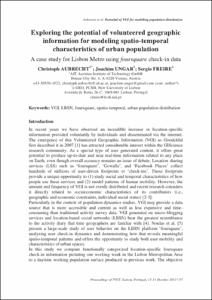Mostra el registre d'ítem simple
Exploring the potential of volunteered geographic information for modeling spatio-temporal characteristics of urban population: a case study for Lisbon Metro using foursquare check-in data
| dc.contributor.author | Aubrecht, Christoph |
| dc.contributor.author | Ungar, Joachim |
| dc.contributor.author | Freire, Sergio |
| dc.date.accessioned | 2014-10-21T15:25:16Z |
| dc.date.available | 2014-10-21T15:25:16Z |
| dc.date.issued | 2011-10 |
| dc.identifier.citation | Aubrecht, Christoph; Ungar, Joachim; Freire, Sergio. Exploring the potential of volunteered geographic information for modeling spatio-temporal characteristics of urban population: a case study for Lisbon Metro using foursquare check-in data. A: Virtual cities and territories. "International Conference Virtual City and Territory (7è: 2011: Lisboa)". Coimbra: University of Coimbra. Department of Civil Engineering; etc., 2011, p. 57-60. |
| dc.identifier.isbn | 978-972-96524-6-2 |
| dc.identifier.isbn | 978-989-97510-0-2 |
| dc.identifier.uri | http://hdl.handle.net/2099/15418 |
| dc.description.abstract | In recent years we have observed an incredible increase in location-specific information provided voluntarily by individuals and disseminated via the internet. The emergence of this Volunteered Geographic Information (VGI) as Goodchild first described it in 2007 has attracted considerable interest within the GIScience research community. As a special type of user generated content, it offers great potential to produce up-to-date and near real-time information related to any place on Earth, even though overall accuracy remains an issue of debate. Location sharing services (LSS) such as ‘foursquare’, ‘Gowalla’, and ‘Facebook Places’ collect hundreds of millions of user-driven footprints or ‘check-ins’. Those footprints provide a unique opportunity to study social and temporal characteristics of how people use these services and model patterns of human mobility. However, the amount and frequency of VGI is not evenly distributed and recent research considers it directly related to socioeconomic characteristics of its contributors (i.e.,geographic and economic constraints, individual social status) . Particularly in the context of population dynamics studies, VGI may provide a data source that is more accessible and current as well as less expensive and timeconsuming than traditional activity survey data. VGI generated on micro-blogging services and location-based social networks (LBSN) bear the greatest resemblance to the activity diary that time geographers are familiar with . Noulas et al. present a large-scale study of user behavior on the LBSN platform ‘foursquare’, analyzing user check-in dynamics and demonstrating how that reveals meaningful spatio-temporal patterns and offers the opportunity to study both user mobility and characteristics of urban spaces. In this study we compare functionally categorized location-specific foursquare check-in information picturing one working week in the Lisbon Metropolitan Area to a daytime working population surface produced in previous work. The objective is to analyze potential correlation patterns and explore options for modeling finescale spatio-temporal characteristics of urban land use based on VGI. |
| dc.format.extent | 4 p. |
| dc.language.iso | eng |
| dc.publisher | Department of Civil Engineering of the University of Coimbra and e-GEO, Research Center in Geography and Regional Planning of the Faculty of Social Sciences and Humanities of the Nova University of Lisbon |
| dc.relation.ispartof | International Conference Virtual City and Territory (7è: 2011: Lisboa) |
| dc.rights | Attribution-NonCommercial-NoDerivs 3.0 Spain |
| dc.rights.uri | http://creativecommons.org/licenses/by-nc-nd/3.0/es/ |
| dc.subject | Àrees temàtiques de la UPC::Urbanisme::Planejament urbà |
| dc.subject | Àrees temàtiques de la UPC::Urbanisme::Aspectes econòmics |
| dc.subject | Àrees temàtiques de la UPC::Urbanisme::Aspectes socials |
| dc.subject.lcsh | Geographic information systems |
| dc.subject.lcsh | Urban density -- Portugal -- Lisbon |
| dc.subject.other | VGI |
| dc.subject.other | LBSN |
| dc.subject.other | Foursquare |
| dc.subject.other | Spatio-temporal |
| dc.subject.other | Urban population distribution |
| dc.title | Exploring the potential of volunteered geographic information for modeling spatio-temporal characteristics of urban population: a case study for Lisbon Metro using foursquare check-in data |
| dc.type | Conference report |
| dc.subject.lemac | Sistemes d'informació geogràfica |
| dc.subject.lemac | Densitat urbana -- Portugal -- Lisboa |
| dc.identifier.doi | 10.5821/ctv.7694 |
| dc.description.peerreviewed | Peer Reviewed |
| dc.rights.access | Open Access |
| local.citation.author | Aubrecht, Christoph; Ungar, Joachim; Freire, Sergio |
| local.citation.contributor | Virtual cities and territories |
| local.citation.pubplace | Coimbra |
| local.citation.publicationName | International Conference Virtual City and Territory (7è: 2011: Lisboa) |
| local.citation.startingPage | 57 |
| local.citation.endingPage | 60 |
Fitxers d'aquest items
Aquest ítem apareix a les col·leccions següents
-
07th Virtual Cities and Territories, Lisbon, October 11 to 13, 2011 [145]
Virtual cities and territories


